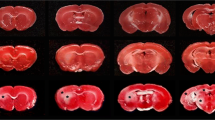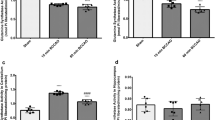Summary
Evolution of infarction following cerebral ischemia is a delayed process, with spongiform degeneration of the neuropil occuring 6 to 8 hours after onset of ischemia. The brains of gerbils with stroke following unilateral carotid artery ligation were examined for catecholamine-derived fluorescence (CADF) by the Falck-Hillarp technique to study the relationship of catecholamine (CA) metabolism with damage to the neuropil. CADF could still be identified in the striatum for up to 16 hours after stroke and there appeared to be spongiform degeneration of the neuropil in relation to accumulations of CADF at 7 and 16 hours after stroke. Pretreatment of gerbils with a-methyl-p-tyrosine 400 mg/kg 6 hours prior to carotid ligation depleted the striatum of CADF until 16 hours after stroke and appeared to reduce the spongiform degeneration of the neuropil, though it did not affect ischemic degeneration of neuronal cell bodies. The continued presence of CADF in the striatum for up to 16 hours after stroke supports the previously reported findings that CA nerve terminals are still functional for 8 hours after stroke and that CA metabolism continues even though levels of CA are reduced immediately after onset of ischemia due to carotid artery ligation.
Similar content being viewed by others
References
Ahagon A, Ishikawa M, Nanda H (1980) Histochemical changes of brain dopamine in an acute stage of cerbral ischemia in gerbils. Stroke 11: 622–628
Brannan T, Weinberger J, Knott P, Taff I, Kaufmann H, Togasaki D, Nieves-Rosa J, Maker H (1987) Direct evidence of acute massive striatal dopamine release in gerbils with unilateral strokes. Stroke 18: 108–110
Corrodi H, Hillarp N-A, Thiem G, Torp LA (1962) Fluorescence of catecholamines and related compounds condensed with formaldehyde. J Histochem Cytochem 10: 348–354
Corrodi H, Hillarp N-A, Jonsonn G (1964) Fluorescence methods for the histochemical demonstration of monoamines. 3. sodium borohydride reduction of the fluorescent compounds as a specificity tes. J Histochem Cytochem 12: 582–586
de la Torre JC, Surgeon JW (1976) A methodological approach to rapid and sensitive monoamine histofluorescence using a modified glyoxylic acid technique: the SPG method. Histochemistry 49: 81–93
Falck B, Hillarp N-A, Thieme G, Torp A (1962) Fluorescence of catecholamines and related compounds condensed with formaldehyde. J Histochem Cytochem 10: 348–354
Kahn K (1972) The natural course of experimental cerebral infarction in the gerbil. Neurology 22: 510–515
Lavyne MH, Moskowitz MA, Larin F, Zervas NT, Wurtman RJ (1975) Brian 3H-catecholamine metabolism in experimental cerebral infarction. Neurology 25: 483–485
Lust WD, Mrsulja BB, Mrsulja BJ, Passoneau JV, Klatzo I (1975) Putative neurotransmitters and cyclic nucleotides in prolonged ischemia of the cerebral cortex. Brain Res 98: 394–399
Maker HS, Weiss C, Silides DJ, Cohen G (1981) Coupling of dopamine oxidation (monoamine oxidas activity) to glutathione oxidation via the generation of hydrogen peroxide in rat brain homogenates. J Neurochem 36: 589–593
Maker HS, Weiss C, Brannan TS (1986) Amine mediated toxicity: the effects of dopamine, norepinepherine, 5-hydroxytryptamine, 6-hydroxydopamine, ascorbate, glutathione and peroxide on the in vitro activity of creatine and adenylate kinases in the brain of the rat. Neuropharmacology 25: 25–32
Meyer JS, Welch KMA, Shigamichi O, Shimazuk K (1974) Disordered neurotransmitter function-demonstration by measurement of norephinepherine and 5-hydroxytryptamine in CSF of patients with recent cerebral infarction. Brain 97: 655–664
Mrsulja BB, Mrsulja BJ, Spatz M, Klatzo I (1976) Experimental cerebral ischemia in Mongolian gerbils. IV. Behavior of biogenic amines. Acta Neuropathol 36: 1–8
Weinberger J, Cohen G (1982) The differential effect of ischemia on the active uptake of dopamine, gamm-aminobutyric acid and glutamate by brain synaptosomes. J Neurochem 38: 963–968
Weinberger J, Cohen G (1985) Nerve terminal damage in cerebral ischemia: Protective effect of alpha-methyl-para-tyrosine. Stroke 16: 864–870
Weinberger J, Nieves-Rosa J (1987) Monoamine metabolism in the evolution of infarction in ischemic striatum. J Neural Transm 69: 265–275
Zervas NT, Hori H, Negoro M, Wurtman RJ, Larin F, Lavyne MH (1974) Reduction of brain dopamine following experimental cerebral ischemia. Nature 247: 283–284
Author information
Authors and Affiliations
Rights and permissions
About this article
Cite this article
Weinberger, J., Nieves-Rosa, J. Monoamine neurotransmitters in the evolution of infarction in ischemic striatum: morphologic correlation. J. Neural Transmission 71, 133–142 (1988). https://doi.org/10.1007/BF01245255
Received:
Accepted:
Issue Date:
DOI: https://doi.org/10.1007/BF01245255




